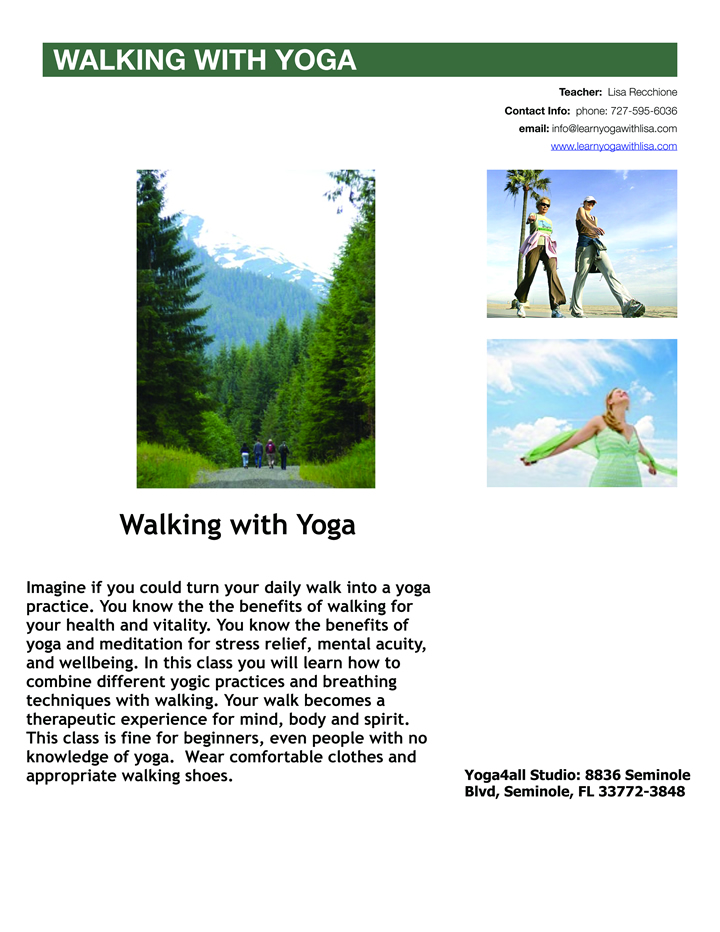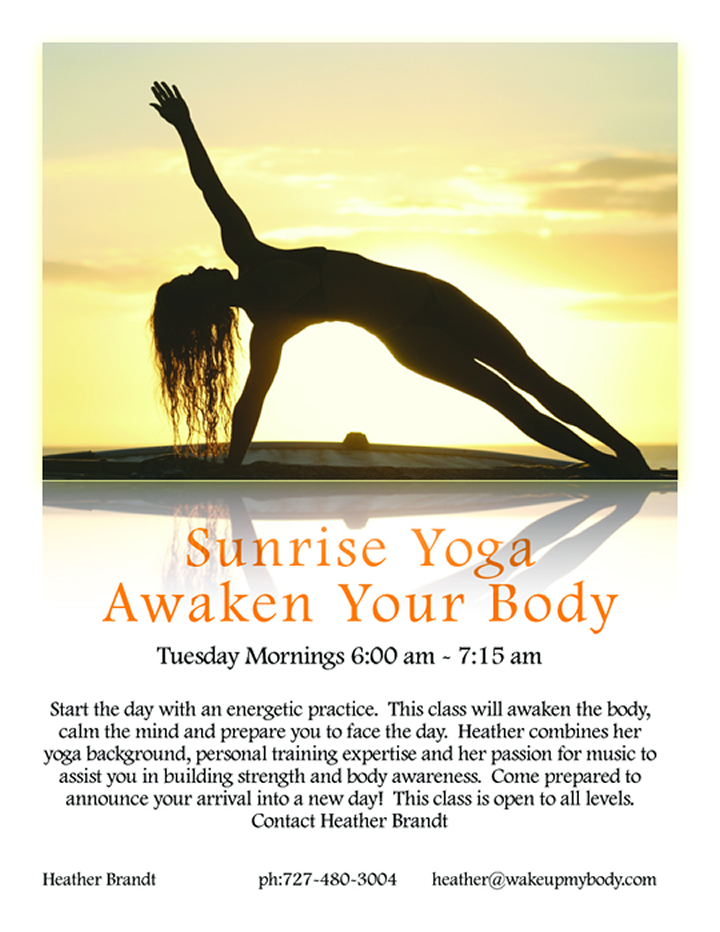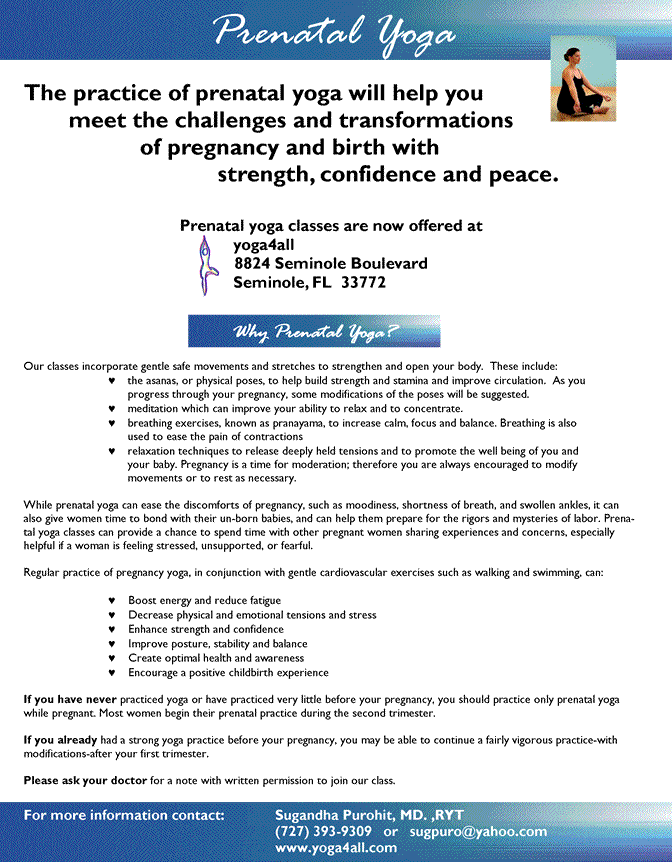
Tag: yoga
Road to Inversions
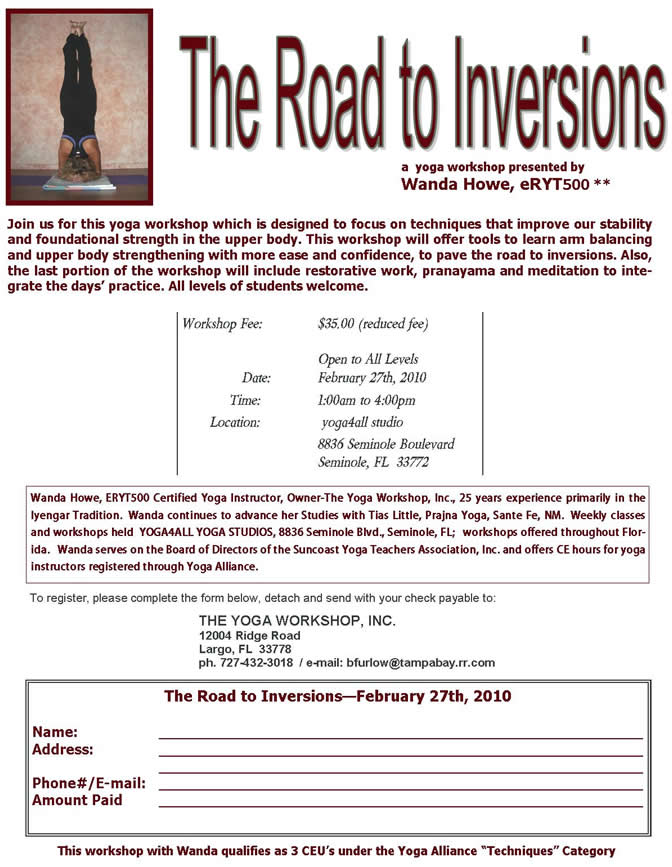
Health Secret Doctors Don’t Know
or
* how to reap the remarkable healing benefits of yoga *
by Timothy McCall, MD, a board-certified internist and medical editor of Yoga Journal.
Yoga is one of the most under-utilized and under-rated medical therapies in the US. It’s extremely rare for American medical doctors to prescribe yoga – most are not knowledgeable about its wide array of health benefits.
What You May Not Know
More than 100 scientific studies show that yoga can improve health problems ranging from heart disease to insomnia…diabetes to arthritis…cancer to bronchitis.
I’m a medical doctor who has practiced yoga for 12 years, and yoga is the most powerful system of health and well-being I have ever seen. By promoting overall health, yoga increases the benefits you may derive from conventional and/or alternative therapies – and may even eliminate your need for medication.
How Yoga Helps
Studies show that virtually all health problems respond positively to yoga. When 2,700 people suffering from a variety of ailments practiced yoga (for at least 2 hours a week for 1 year or longer), it helped 96% of those with back disorders…94% of those with heart disease…90% of those with cancer…90% of those with arthritis…88% of those with bronchitis or asthma…and 86% of those with diabetes.
What’s responsible for these salutary effects? Yoga, which is practiced by children as well as adults well into their 90s, can:
- Increase Flexibility by strengthening muscles that improve posture and balance
- Boost Immunity by reducing levels of the stress hormone cortisol and increasing the circulation of lymph (a fluid rich in immune cells)
- Enhance Lung Function with slower, deeper breathing that promotes oxygenation of tissues
- Strengthen Bones and Joints and nourish the cartilage in spinal discs…improve range of motion and help to deliver nutrients to the bones & cartilage.
- Condition the Heart & Circulatory System by lowering blood sugars and artery-damaging high blood pressure…and improving levels of cholesterol and triglycerides (blood fats).
- Relieve Pain due arthritis, back problems, fibromyalgia and carpal tunnel syndrome, scoliosis, etc. by reducing muscle spasms, improving the alignment of bones in joints and teaching people to separate pain from their emotional response to the pain.
- Improve Brain Function by increasing neurotransmitters (brain chemicals) and activating the left prefrontal cortex in the brain that reduces anxiety and anger.
Getting the Benefits
- Talk To Your Doctor. Some yoga practices are not recommended for people who suffer from specific conditions (for example, people with damaged retinas from diabetes should avoid upside down poses like shoulder stand because these poses can increase pressure in
the eyes.) - Choose the Right Instructor. Large group yoga classes are great preventa tive medicine for people who are relatively fit and flexible. Those with chronic medical conditions are often better off working with a teacher privately or in a small group. Talk to the teacher before you attend and explain your situation. If the class doesn’t fit your needs, ask for a recommendation for another class/teacher.
- Find An Experienced Teacher. Some styles of yoga require teachers to undergo 200-500 hours of training to be certified. Warning: Some yoga teachers may have completed only a weekend training course to become “certified”. Before attending a yoga class ask the instructor how long he/she trained. (200-500 hours is standard.)
- Pay Attention to Your Body. If you experience sharp pain when you do a yoga pose, STOP. If you perform breathing exercises and feel short of breath, STOP. Tell the teacher as soon as possible.
- Practice Regularly. The key to success is steady practice -once a day is ideal, once a week is better than none at all. Yoga works well as part of an overall fitness program that includes aerobic exercise.
- Be Patient. Most drugs work fast but the longer you take them the less effective they become. Yoga is not a quick fix. The longer you practice it, the more effective it becomes. Yoga is slow – but strong – medicine. This doesn’t mean you won’t see immediate results. Just a little bit of added flexibility, strength, and balance can make a huge difference in how you function day to day.
Some yoga techniques can help you instantly in stress-provoking situations such as getting stuck in traffic. Example: counting silently, inhale for 3 seconds and exhale for 6 seconds. Repeat breathing smoothly and gently. In a few breaths you’ll feel calmer.
Walking with Yoga

Learn the tools of yoga and establish a personal yoga practice
This program introduces the concepts of stress reduction and wellness from a whole-body perspective. It presents basic information on the link between stress and illness, and introduces participants to concrete and specific yoga-based tools to cope with stress and to promote healing. Students will leave this program with an understanding of how yoga helps maintain health. They will learn how to use yoga tools in their daily lives, to deal effectively with stress and promote wellness.
Course Curriculum
Week 1: “What will I learn?” Yoga, Stress Reduction and the Body Systems
Week 2: Core Postures and Importance of Breathing
Week 3: Healthy Bones, Joints and Muscles
Week 4: Healthy Immune System
Week 5: Opening to Life: Integrating the course
Class description: Each week explore a core posture in-depth, and then continue through a soft flowing practice. There is a strong emphasis on linking breath and movement. Classes conclude with breathing practice and a guided meditation period. These classes are appropriate for beginners and intermediate yoga practitioners.
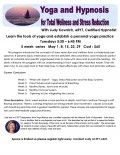 Click the image to view the Yoga and Hypnosis for Total Wellness and Stress Reduction flyer
Click the image to view the Yoga and Hypnosis for Total Wellness and Stress Reduction flyer
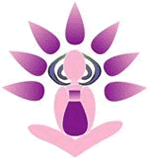 |
Aromatherapy for Your Yoga Practice Susan Wasserman, RYT 500, CAP |
The therapeutic benefits of essential oils have been recognized by advanced cultures since ancient times. For over 5000 years, ayurvedic healers and Yogis used these precious substances to sanctify their environment, beautify their bodies and to promote health, well being and longevity. In this workshop, you will learn:
- Ayurveda & Aromatherapy- the medicine of Yoga
- Your ayurvedic body type (dosha) and how to recognize imbalances
- The therapeutic use of essential oils for your body type and for common ailments
- Essential Oil blending instructions and simple recipes
- Ayurvedic self massage and basic reflexology techniques that can be used on yourself and your Yoga students
- The etheric energy of essential oils and how they can awaken the chakras
- How the combination of the earth’s minerals (crystals, stones) and essential oils work synergistically to balance your ayurvedic dosha
The fee is only $45.00, which includes lots of handouts and a personal spray blend to take home! This class also qualifies for 3 CEUs for Yoga Alliance Teachers. Yoga Flow Essential Oils will be available for sale. You must pre-register for this workshop so adequate supplies are available.
Susan Wasserman RYT500 is a certified yoga therapist, ayurvedic clinical consultant and aromatherapist. Essential oils are Susan’s passion, and her ten year process included study with fourth generation aromatherapists from Europe and India. Susan owns Yoga Flow Essential Oils and is the executive director of the Suncoast Yoga Teacher’s Association.
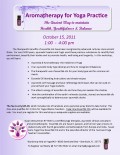 Click the image to view the Aromatherapy for Your Yoga Practice flyer
Click the image to view the Aromatherapy for Your Yoga Practice flyer
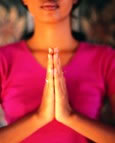 Older participants not only gained better memory but their brains worked better
Older participants not only gained better memory but their brains worked better
June 12, 2007 – Your memory getting faulty? Cognitive ability not what it used to be? New research with older people finds stopping other activity for a daily meditation session can improve your thinking and your memory. The leader of the study thinks these daily 12-minute Yoga sessions may even prevent Alzheimer’s disease.
"This exciting study confirms what we have been observing in clinical practice for many years, that meditation is one of the most effective tools to address memory loss," said Dharma Singh Khalsa, M.D., president and medical director of the Alzheimer’s Research and Prevention Foundation, the non-profit organization which sponsored the study.
"While we are planning additional research in this area, we can say today with confidence that daily meditation is recommended as part of an integrated brain longevity strategy to delay, even prevent, cognitive decline," he continued.
Andrew Newberg, M.D., assistant professor of radiology at the University of Pennsylvania School of Medicine, and the study’s principal investigator, concurred.
"For the first time, we are seeing scientific evidence that meditation enables the brain to actually strengthen itself, and battle the processes working to weaken it," said Newberg.
"If this kind of meditation is helping patients with memory loss," he continued, "we are encouraged by the prospects that daily practice may even prevent neurodegenerative diseases such as Alzheimer’s."
Practiced by millions of individuals to reduce stress and anxiety, improve concentration, and even lower blood pressure, meditation is among the most commonly used alternative therapies in the world.
Yesterday, at the Alzheimer’s Association’s International Conference on the Prevention of Dementia in Washington, D.C., results from a University of Pennsylvania study were unveiled confirming for the first time that daily practice of meditation can improve cognitive function among individuals with memory complaints.
Researchers began their investigation by conducting a series of neurological and memory tests on each subject, who ranged in age from 52-70, with either a history of memory complaints or a diagnosis of mild cognitive impairment.
Single Photon Emission Computed Tomography (SPECT) scans, a brain imaging technique which measures cerebral blood flow, were also conducted on each subject.
Following the initial tests, subjects were taught the techniques of Kirtan Kriya, the most widely practiced meditation in the Kundalini Yoga tradition, and instructed to practice a 12-minute meditation each day for eight weeks. This form of Yog is a repeated chanting of sounds and finger movements designed to help the mind focus and become sharper. (Read more below)
While follow up testing confirmed statistically significant improvements in memory among all of the study’s subjects, the most significant outcome of the study was the stark contrast between the pre and post-training SPECT scans.
Follow up scans showed dramatic increases in blood flow to the posterior cingulate gyrus, the region of the brain associated with learning and memory. It is the first region of the brain to decline in individuals diagnosed with Alzheimer’s disease, which helps to explain why the blood flow-producing meditation has such a profound impact on cognitive functioning.
Article from: http://www.SeniorJournal.com/NEWS/Alzheimers/2007/7-06-12-DailyYoga.htm
For more about this study and the Kirtain Kriya practice used – http://www.alzheimersprevention.org/research.htm
For more information, please visit the Alzheimer’s Research and Prevention Foundation – http://www.alzheimersprevention.org/.
Join Lisa Recchione, RYT for her monthly class — Yoga for the Brain
Daily Yoga Helps Prevent Headaches
By Ellen Serber
When it comes to preventing or curing a headache, there is no substitute for a thorough, daily yoga program. The following sequence offers poses that are helpful for opening the chest and stretching and relaxing the upper back and neck. Include them in your regular practice if you are prone to headaches and see if they help bring some relief and new awareness. Breathe deeply and slowly during all the postures and remember to relax the forehead, eyes, jaw, and tongue. The first part of the program is prevention, practiced when you do not have a headache. The second part, beginning with Supta Baddha Konasana, may be helpful in relieving a headache when it first begins. You will have better results if you start stretching and releasing at the first sign of a headache, before the muscles go into spasm.
Tadasana (Mountain Pose): Discovering alignment and finding the center Standing upright with awareness is one basic way to discover your own unique posture. It is difficult to correct something until you have found out what is really there. Use the wall to identify your alignment, and then practice standing in the center of the room.
Stand with your back to the wall, with your feet together. If that is uncomfortable, separate the feet three or four inches. Plant the feet firmly, feeling the ground with the soles of the feet. Check the distribution of weight between the right foot and the left. Move front, back, and side-to-side on your feet to find the most balanced stance. Make sure that the arch of each foot is lifted, the toes spread apart. The placement of your feet becomes the foundation of your awareness of your whole body. Give yourself enough time to explore and discover how you are actually standing.
When you are ready to move on, firm and straighten the legs. Bring the tailbone and pubic bone towards each other, but do not suck in the abdominals: Lift them. There should be space between the wall and your lower back; do not flatten the lumbar curve. With your "mind’s eye," go into the area below the navel, inside the belly, in front of the sacrum. Locate this "center" point. Extend the side torso up, lift the sternum without sticking out the ribs, and drop the shoulders. Take the tips of the shoulder blades and move them into the torso, opening the chest. Let the back of the head reach up. If the chin is raised, let it drop slightly, without tightening your throat; focus your eyes on the horizon. Make sure that the shoulders and back of the head both touch the wall. Relax any tension in the face and neck. Remember that your "center" resides in the area below the navel and in the belly, not in the neck and head. This exercise may feel very constricted if your head is normally forward of your shoulders. Use the wall to inform you, so that you know the relationship of your head to your shoulders, but try not to create more stress as you adjust your alignment.
On an exhalation, raise the arms up to the ceiling, bringing the elbows back by the ears. Let the arms grow from the shoulder blades. Stretch the little finger side of the hand and connect that stretch all the way down to the little toe and into the ground. Remember to keep the feet grounded, the legs strong, and the center of your pose in the area below the navel. Observe whether the movement of the arms has caused tension in the neck area. As you stretch up with the hands, bring the tips of the shoulder blades more deeply into the torso. Hold for a few breaths and then release on an exhalation.
Parsvottanasana arms: Opening the chest Move a little away from the wall and roll the shoulders back. Clasp your elbows with your hands behind your back. If you have more flexibility you may join your palms behind your back, with the fingers pointing upward. On the exhalation, roll the upper arms back toward the wall, opening the chest between the sternum and shoulder. As you open, keep the ribs relaxed; make sure they don’t jut forward. Remember to stay grounded in your feet and center the movement below the navel. Relax the eyes, jaw, and tongue. Release on the exhalation. Change the arm on top, if you are clasping your elbows, and repeat.
Garudasana arms: Opening between the shoulder blades This pose is helpful for relieving pain between the shoulder blades. It reminds us to keep that area open in the process of stretching the upper back. Wrap your arms around your torso, right arm under the left arm, hugging yourself. Exhale and bring the hands up, the left elbow resting in the right elbow, with the hands rotated palms towards each other. Breathe and feel the stretch; after a few breaths, raise the elbows up higher, to the level of the shoulder. Remain grounded in the feet, centered in the area below the navel. Relax the eyes, jaw, and tongue. Feel the expansion of the inhalation between the shoulder blades and the release on the exhalation. Lower the arms on the exhalation and repeat with the left arm under the right.
Being vs Doing
To many people, there seems to be an inherent conflict between being in the present and accomplishing everything that needs to get done. But do you have to choose between your housework and meditation?
By Stephan Bodian
If you practice hatha yoga, you’re no doubt familiar with this scenario: You’ve had an invigorating and inspiring practice session in which your mind was totally focused on your body and your breath. By the time you’re done, you have a deep sense of peace and relaxation that seems to pervade every cell. You feel centered, balanced, in touch with yourself. You vow not to let this feeling slip away as the day progresses.
But halfway through the work day, you’re overwhelmed by the press of urgent e-mails and encroaching deadlines, and you’ve completely lost the connection and composure you had. Even more disturbing, you have no idea how to get it back. It’s as if a door has closed on a deeper dimension, a place of balance and flow, and you can’t figure out how to open it again. By the end of the day, you’re frazzled and stressed out, and you can’t wait to get home to your yoga mat.
Of course, you don’t have to be a hatha yogi to be acquainted with this terrain. Perhaps you find your connection to being through tai chi or running, walking in nature or playing with your children. Whatever the activity, you enter a zone where you feel poised, open, relaxed, and attentive. In the midst of the doing, there’s a sense of enjoyment, fulfillment, and alignment with a deeper current of aliveness. But as soon as you position yourself behind the wheel of your car or sit down in front of your computer, you tense your shoulders, hold your breath, increase your speed, and lose touch with yourself. What happened, you wonder. How did I lose my balance? Where did I go wrong?
The Crucible of Everyday Life
As a zen teacher and psychotherapist, I’ve worked with hundreds of meditators, hatha yogis, and spiritual seekers who agonize over this issue. They’ve read the latest books, heard the teachings, attended the retreats, practiced the techniques diligently, and vowed to implement them. Yet they continue to be seduced back into their old habits and routines: overbooking their schedules, speeding up to match the pace of their technological devices, completely forgetting to stop, breathe, and be present. Instead of bringing what they’ve learned on their meditation cushion or yoga mat to the crucible of everyday life, they lose their balance and go unconscious again and again.
There’s no question that we live in uniquely challenging times. We’re working longer hours, taking fewer vacations, and feeling more hurried and stressed than ever before. At the same time, our lives are changing more rapidly, and we can no longer rely on keeping the same job or partner for a lifetime—or even for the next few years. As a result, we’re constantly confronted with major life choices that seem to threaten our physical survival and require that we spend more time than ever in our minds, assessing and deciding. "Our lives are extraordinarily complex," says psychologist Joan Borysenko, Ph.D., author of Inner Peace for Busy People (Hay House, 2001), "and we’re being bombarded with choices, both significant and trivial, that demand a great deal of effort and energy to make."
Not only do our lives move faster, but they also lack the flow of simpler times, when the measured rhythms of nature and physical labor modeled an intrinsic balance between being and doing. These days we’re pulled staccato from one urgent input to another, from cell phone to e-mail, PalmPilot to pager, forced to mold our analog bodies to the digital age. "The sheer volume of information impinges on us and keeps us in a state of physiological arousal," says Borysenko.
Given the unprecedented demands of postmodern life, perhaps we just expect too much of ourselves. Without the supportive structure of sacred communities like monasteries and ashrams, in a secular world that seems to be spinning insanely out of balance, is it really possible to stay consistently connected to just being while pursuing material success, a healthy body, a fulfilling relationship? "What’s new to our times is not that we’re having difficulty maintaining balance, but that so many people who don’t live in monasteries have awakened to the spiritual dimension and don’t quite know how to find a place for it in their lives," observes Buddhist psychiatrist Mark Epstein, author of Going on Being (Broadway Books, 2001).
Certainly regular retreats and workshops can help. As we deepen and expand our awareness, we find it easier to notice when we’re lost in striving so we can more readily reconnect with the present moment. But intensive practice is not necessarily a panacea. In fact, I’ve watched many clients, friends, and colleagues struggle with the transition from retreat to everyday life. "After my first vipassana retreat in 1980, I saw a legitimate way to slow down and relax," says Anna Douglas, a founding teacher at Spirit Rock Meditation Center in Woodacre, California. "I was given permission to move at the rhythm of life. Then I entered a phase of trying to make my life like this all the time. I got rid of my belongings, became a retreat junkie, and dreaded going back into the world." As her practice matured, however, Douglas saw that she needed to integrate retreat life and daily life. "Meditation teaches us the value of being, but we need to bring this being quality into the doing world."
The Ultimate Forgetting
The deeper question is, "What prevents us?" In a memorable exchange with my teacher, Jean Klein, a master of Advaita and Kashmiri yoga, I asked him whether it was possible to stay connected to being in the present even in the most difficult life situations. He invited me to see that I was trapped in a world of spiritual concepts and to notice the moments in daily life when the sense of a separate me was absent. I stopped to absorb what he had said. "Yes," I responded finally, "I know what you’re talking about. But somehow I keep forgetting." "Ah, forgetting," he said, with a knowing smile. "The ultimate forgetting."
Despite our best intentions, there seem to be powerful inner forces at work that induce this "ultimate forgetting" and sabotage our genuine attempts to create balance and peace in the midst of activity. From my experience with clients, friends, and my own spiritual unfolding, here is a list of the most influential:
Our self-worth is linked to our accomplishments. As children, we’re asked by well-meaning relatives, "What do you want to be when you grow up?" As adults the first words out of our mouths when we meet for the first time are "What do you do?" The message is clear: We’re valued for what we contribute, not for who we really are. Since we all want to be loved and appreciated, there’s an enormous incentive to work harder and faster but hardly any encouragement to slow down, do less, and enjoy life more. This further fragments our already disjointed lives and drains away the spontaneity. "Even over-scheduling wonderful things can take the joy out of life," says Douglas.
We’re driven by a relentless inner critic. Most, if not all, of us have internalized a deeply ingrained set of beliefs about duty, perfectionism, and responsibility that have been passed down through the generations. "There’s a suspicion in our culture about being," says Douglas. "Our puritan ethic teaches us to be productive and responsible. Our mission in life is to acquire, to accomplish, to succeed." We’re taught that we’re inadequate as we are and need to improve—and spiritual teachings can merely compound this low self-worth by relentlessly encouraging us to compare ourselves (unfavorably, of course) to some lofty spiritual ideal: What, you can’t stop your thoughts at will, or remain in Headstand for five minutes, or feel compassionate in all situations? Because it apparently has the best of intentions, the spiritual critic is especially insidious; while driving us to be exemplary meditators or yogis, it can cut us off from the inherent perfection of being, which is always available.
We’re afraid of losing control. If we really slowed down to a more balanced pace and took time to enjoy life, what might happen? Would anything get done? Would we survive? Frightened of loosening our grip and free-falling into an imagined abyss, we struggle to impose our agenda on life while contracting away from the natural, ever-changing, and unpredictable flow of being. Like Arjuna on the battlefield when Lord Krishna reveals his splendor in the Bhagavad Gita, the mind is innately terrified of being because it represents mysterious, unexplored terrain. In fact, the mind’s job is to resist the unknown and create a false ground of security, constructed of beliefs and identities designed to protect us from the groundlessness of impermanence and change. As the great spiritual traditions teach, however, our essential nature is far vaster than the mind can encompass.
We make a strong demarcation between sacred time and secular time. Sure, it’s OK to be present on my meditation cushion or yoga mat, we tell ourselves, but the rest of the time I have too much to do. So we compartmentalize our lives into sacred and secular, being and doing, and reserve our sadhana for certain prescribed periods each day. The secret is to view every moment as fertile ground for practice, as yet another opportunity to wake up to the beauty and sacredness of life.
We lack the commitment or motivation to stay present. Despite our repeated vows to remain balanced in all situations, our loyalties are divided between our spiritual aspirations and the fleeting satisfaction of excitement, accomplishment, and acquisition. "Why do we get knocked off our center? Perhaps we don’t have a wholehearted commitment to a path or a teacher," suggests John Friend, founder of Anusara Yoga. "When I’ve had dry periods, I’ve found that I’ve lost touch with my commitment to my teacher or my love for my path. When I rededicate myself with passion, I feel rejuvenated and more motivated to stay connected." An oft-repeated Tibetan Buddhist slogan echoes Friend’s remarks: "Everything rides on the tip of your motivation." But, motivation is not some quality that can be cultivated—it comes from deep inside, from suffering or desperation, from what the Tibetans call bodhichitta (the heartfelt wish for the happiness of all beings), from trust in our teachers, and from a profound desire to wake up and be free. Unless we keep asking ourselves, “What are my priorities right now?" we tend to lapse back into old unconscious patterns.
We don’t recognize being in the midst of doing. Many people mistake being for a familiar feeling or experience they’ve had in meditation or yoga practice, such as peace, relaxation, or a pleasant current of energy. Then they try to "reconnect with being" by recapturing the buzz. But feelings have an annoying habit of coming and going and resisting our attempts to control or reproduce them. Being is much more immediate than that—it’s the pause between thoughts, the space in which everything comes and goes, the stillness underlying all activity, the awareness that’s looking out through our eyes right now. Immediate though it may be, it nevertheless eludes our efforts to "make it happen" or grasp it conceptually—and it’s so subtle and empty of content that the mind may overlook it. If we open to our experience just the way it is, however, we can attune to being. Paradoxically, this simple attunement often, though not always, gives rise to the very experiences we were trying to reproduce in the first place.
We’re addicted—to speed, achievement, consumption, the adrenaline rush of stress, and, most insidiously of all, to our minds. At the heart of our resistance to being—indeed, at the heart of our speed and our stress—is the incessantly chattering “monkey mind,” which is obsessed with past and future, loss and gain, pleasure and pain. The mind is terrified of the present moment, which is where "being" inevitably occurs. In fact, it’s the mind that gives doing a bad rap, because the attachment and struggle it generates makes many forms of doing so unpleasant. This compulsive mind constructs a separate sense of self, often called the ego, that’s trapped in a world of psychological time, surrounded by other separate selves that threaten its survival. It then invents the spiritual search and other self-improvement schemes as an attempt to escape the trap it has created for itself. The only way to kick this addiction to the mind and its creations, advises Eckhart Tolle in The Power of Now: A Guide to Spiritual Enlightenment (New World Library, 1999), is to awaken to our identity with something much vaster—being itself, our essential nature.
Portals to Being
From the highest spiritual perspective, we can never lose our connection with being. In fact, the separation between being and doing is just another fabrication of the mind. No matter how still we try to become, doing is always happening: The heart is beating, the lungs are breathing, the internal organs are functioning, the eyes are blinking. In the words of the Bhagavad Gita, "Not even for a moment can anyone remain without performing actions. Everyone is unwittingly made to act by the primary qualities born of nature." In the end, any attempt to be, whatever that might mean, is just another form of doing.
So the question is not, "Are we doing or being?" But rather, "How do we relate to our actions?" Do we identify ourselves as the doer, the separate individual who struggles to achieve and survive, or do we remain unattached to the fruits of our actions, as the Gita and other sacred texts recommend, and identify as the observer or witness of life as it unfolds?
"You can learn to be and do at the same time," notes Rodney Yee, coauthor of Yoga: The Poetry of the Body (St. Martin’s Press, 2002) and director of the Piedmont Yoga Studio in Oakland, California. "If you’re flowing down a river, you’re just being, yet you’re moving downstream. The present moment is like that. If you concentrate your attention in the moment, you’re totally present, yet it’s not stagnant or fixed. The stillness is the state of mind that observes the movement."
However, until we experience this stillness—which is actually not an experience or mind-state, but the deeper stillness of being that underlies and pervades all experience—we can’t realize the union of doing and being that the great spiritual texts describe. Where do we discover this stillness? In the timeless moment, the eternal Now, free of the conceptual overlays of past and future. As the scriptures remind us, time is merely a creation of the mind, and only the Now exists. When we awaken to our identity with this timeless dimension, the problem with finding a balance between doing and being drops away as the separate self-sense dissolves, and all that’s left is simply life living itself.
This may sound like a lofty, unattainable state. However, both meditation and hatha yoga, if practiced without effort or struggle, can be living portals to the Now. "Asana practice is the continual refinement of staying present with the mind so time stops," says Yee. "When you’re just being, you lose the aspect of time, but you don’t lose movement. When the mind stays steady on the moment, there is no time."
In Zen, the corresponding approach to meditation is called "just sitting." There’s no attempt to achieve some particular state of mind, not even satori, but merely a steady presence in the Now. Of course, this practice needn’t be confined to the cushion: In everyday life it takes the form of "just walking," "just eating," "just driving." In other words, total absorption in every activity without separation.
Ultimately, the attempt to find balance becomes irrelevant when we recognize that reality is by its nature a seamless, indivisible union of the two—the dance of Shiva and Shakti, the meeting point of consciousness and its manifestations, the absolute and the relative, the timeless and the time-bound. "For me, being and doing are complementary and come out of the same spirit, the same universal presence," says Friend. "At the ultimate level consciousness is spacious, vast, luminous, completely free. Out of this ground of being everything arises: material reality, thought, emotion, activity."
Even though we may appear to lose our equilibrium again and again, our search comes to an end when we awaken to a deeper dimension. This is the supreme view taught by the great masters and sages of every spiritual tradition. "The reason everything looks beautiful is it is out of balance, but its background is always in perfect harmony," observes Zen master Shunryu Suzuki in his classic book of talks, Zen Mind, Beginner’s Mind (Weatherhill, 1997). "This is how everything exists in the realm of Buddha nature, losing its balance against a background of perfect balance."
Stephan Bodian is a personal coach, Dharma teacher in the Zen tradition, and the author of several books, including Meditation For Dummies (Hungry Minds, Inc., 1999).
July/August 2002
This article can be found online at http://www.yogajournal.com/wisdom/723_1.cfm

